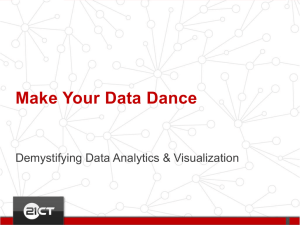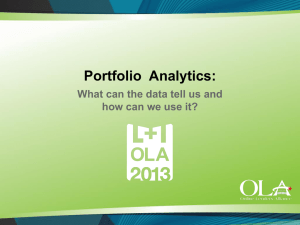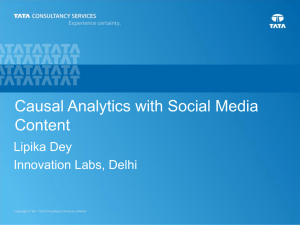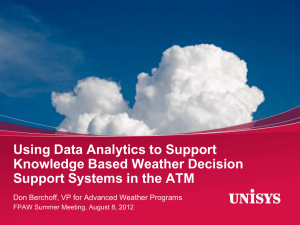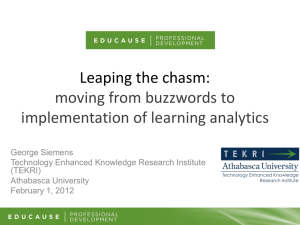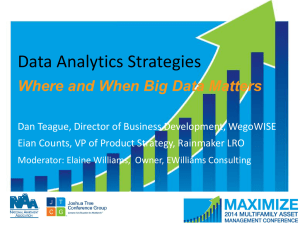Social Business
advertisement
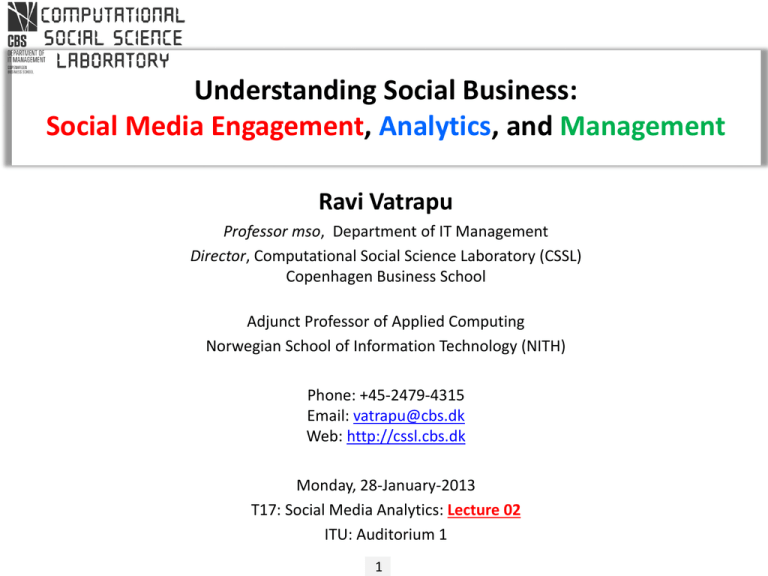
Understanding Social Business: Social Media Engagement, Analytics, and Management Ravi Vatrapu Professor mso, Department of IT Management Director, Computational Social Science Laboratory (CSSL) Copenhagen Business School Adjunct Professor of Applied Computing Norwegian School of Information Technology (NITH) Phone: +45-2479-4315 Email: vatrapu@cbs.dk Web: http://cssl.cbs.dk Monday, 28-January-2013 T17: Social Media Analytics: Lecture 02 ITU: Auditorium 1 1 OUTLINE The Internet Revolution Current Trends Business Transformations Social Business Social Media Engagement Social Media Analytics Social Media Management Teaching (Courses, Case Books, & Supervision) Software: SODATO (Social Data Analytics Tool) 2 “Why companies should be on facebook” What do you think? because it is there everybody else is there expected by customers demanded by customers hijacked by customers business value 3 Trends Ubiquitous & Pervasive Computing Participatory Turn of the Internet “Digital Natives” & “Digital Immigrants” Digital Positivism Civic Panopticon (Vatrapu, 2008) (Vatrapu, 2008) 4 TECHNOLOGIES OF PRACTICAL REASON (F OUCAULT, 1988) Four Matrices of Practical Reason Technologies of Production Technologies of Sign Systems Technologies of Power Technologies of the Self 5 Internet and Business (Li & Leckenby , 2007) Vertical Integration of Channel Capacities Communication Transaction Distribution Horizontal Integration of Marketing Communications Advertising Public Relations Sales Promotion Direct Marketing 6 SOCIAL BUSINESS Doing Business on Social Channels Concomitant Convergence Services: Local, Social, Mobile Media: Owned, Paid, Earned Interactions: My Place, Your Place, Our Place Scorecards: People, Planet, Profit 7 Part I: Social Media Engagement 8 Internet’s Effect on Decision Heuristics (Mishra & Olshavsky , 2005) Impact on all Four Components of Consumers’ Choice Space: 1. Evaluation Strategies 2. Evaluative Criteria 3. Consideration Set 4. Image of Alternatives within the Consideration Set 9 MARKETING AND EXCHANGE-1 (HOUSTON & GASSENHEIMER, 1987) Value Potential for use Potential for exchange TAKEN FROM (HOUSTON & GASSENHEIMER, 1987) 10 MARKETING AND EXCHANGE-2 (HOUSTON & GASSENHEIMER, 1987) Turning Exchange Events into Exchange Relationships TAKEN FROM (HOUSTON & GASSENHEIMER, 1987) 11 Part II: Social Media Analytics 12 13 14 SOCIAL BUSINESS CONUNDRUM Social Data Social Graph (Actors, Actions, and Artifacts) Social Text (Topics, Keywords, Pronouns, & Sentiments) Social Data Issues Key Performance Indicators (KPI) Return on Investment (ROI) Campaign Duration (3 days– 1 year) Pre-Click vs. (Non)Click vs. Post-Click What about House Data? 15 SOCIAL MEDIA SCORECARDS Systematize the field Academic Rigour + Industry Relevance Knowledge-Creation + Problem –Solving “Meaningful and Actionable Insights” Include “Ultraviolet” Social Data Web Analytics Integrate House Data (social-CRM and such) Training and Certification 16 Part III: Social Media Management 17 THE RELATIONAL VIEW (DYER & SINGH, 1998) Three Views on the Sources of Competitive Advantage: 1. The industry structure (Porter, 1980) “supernormal returns are primarily a function of a firm's membership in an industry with favorable structural characteristics (e.g., relative bargaining power, barriers to entry, and so on)” 2. The resource-based view (RBV) “differential firm performance is fundamentally due to firm heterogeneity rather than industry structure” 3. The relational view ”Idiosyncratic interfirm linkages may be a source of relational rents and competitive advantage” 18 SOCIAL MEDIA STRATEGY-1 Taken from (Wollan, Smith, & Zhou, 2011) 19 SOCIAL MEDIA STRATEGY-2 Taken from (Wollan, Smith, & Zhou, 2011) 20 SOCIAL MEDIA AND EMPLOYEE EMPOWERMENT Taken from (Wollan, Smith, & Zhou, 2011) 21 SOCIAL BUSINESS: ORGANIZATIONAL ROLES 22 Social Business Maturity (Spondor, 2011) Level 1: Monitoring Level 2: Online Research Level 3: Social Targetting and Data Management Level 4: Social Business Collaborations 23 TeachingResearch Courses Online Marketing (Fall 2009, Spring & Fall 2010, Spring 2011, Fall 2012) Social Media Analytics (Fall 2011, Spring & Summer 2012) Social Media Management (Spring, Summer, & Fall 2012 Projects with real companies Jobs Case Book Social Media Engagement Social Media Analytics Social Media Management 24 NETWORKED BUSINESS FACT BOOK 2012 Strategic Partnership Survey of Perceptions, Practices, and Value Generation with Social Media, Mobile, and Cloud Computing 2729 Respondents/Orgnaizations Private: 2432 Public: 297 25 Software: SOGATO 26 Discussion vatrapu@cbs.dk http://cssl.cbs.dk 27

